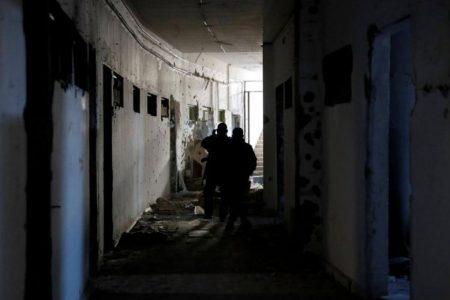
After ISIS, rotting corpses and empty jail cells in Syria’s Raqqa
Days ago in Syria’s Raqa, die-hard jihadists made their final stand in the city’s national hospital. On Wednesday, it stood eerily silent, its entrance inhabited only by swarming flies and two rotting corpses.
Each body lay next to an overturned motorcycle on the side of a thoroughfare leading to the abandoned, bullet-riddled complex, which US-backed Syrian Democratic Forces announced on Tuesday was clear of Islamic State group fighters.
The national hospital and the city’s football stadium were the last two IS holdouts in Raqa, once the notorious capital of the group’s self-styled caliphate, and their recapture marked the end of the jihadists’ three-year rule over the city.
Outside the hospital, one of the two charred and decomposing corpses wore an explosive belt.
Scattered on the rubble-littered ground nearby were Korans, boxes of medication and gauze, and a tiny black notebook full of dates and phone numbers for IS administrative bureaus in the city.
One Syrian number was marked “Whatsapp number for my wife, Umm Islam the Moroccan”.
The SDF said 22 foreign jihadists were killed in the final operation to take the medical facility, which is expected to be thoroughly searched and cleared of mines in the coming days.
At least two blasts, likely mines left behind by IS, could be heard across the ravaged city on Wednesday.
At the abandoned national stadium, two bulldozers were working to clear the field, pressing metal fences, dirt, and rubble into compact mounds along its edges.
Underneath rows of seats, an oval hallway was lined with makeshift cells where civilians accused of breaking the group’s ultra-conservative rules were kept for days.
SDF member Ahmad al-Hassan was one of them.
The young man was detained in 2015 after he tried to prevent an IS fighter from arresting his wife for showing her face briefly in the street.
On his first visit back to Raqa on Wednesday, he returned to the stadium to see the barren room where he was kept for seven days with 35 other men.
He stood wide-eyed and silent in the darkened corridor, barely able to speak.
“This is where they humiliated us. They humiliated us civilians,” he muttered.
In another cell, a handwritten message was scrawled in black marker on the wall: “God save us. God help us.”
The months-long drive by the SDF to capture Raqa was backed by heavy US-led air strikes and artillery fire.
The outer neighbourhoods of the city, the first to be taken, were heavily damaged.
But closer to the city centre, where fierce, urban clashes raged for weeks over strategic multi-storey buildings, the devastation is also striking.
Entire neighbourhoods look like they have been put through the shredder, with homes and shops reduced to nearly indistinguishable piles of concrete cinderblocks, pipes and wires.
With no civilians in sight, the only clues that Raqa was once home to tens of thousands of people are now sprinkled in the filthy streets: a student’s notebook, teardrop-shaped crystals that once hung from a chandelier, a heart-shaped cushion emblazoned with cartoon characters.
A battered blood-red couch hung out of the gap in a building where a balcony used to be. A wardrobe inside is exposed, its door flung open revealing an untouched row of men’s shirts.
SDF fighter Ismail Khalil, also from Raqa, strolled through a ravaged street leading away from the Al-Naim roundabout, site of some of the jihadists’ most notorious crimes.
He gingerly took a few steps into the massive Harun Al-Rashid park, once a favoured gathering spot for families and couples but now reduced to a rubble-strewn wasteland.
“They say want to be rebuild Raqa. What rebuilding?” the stocky 35-year-old said, shaking his head.
“It won’t be rebuilt in 20 years. This city has been completely destroyed.”
Source: Daily Mail





